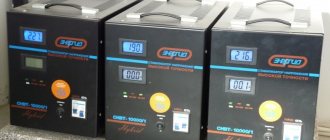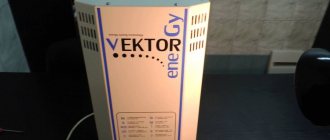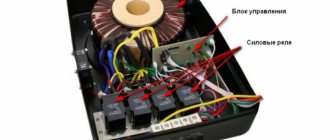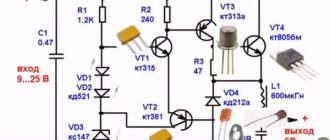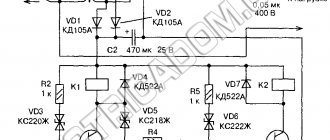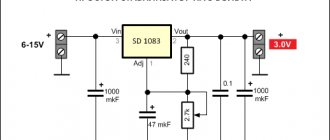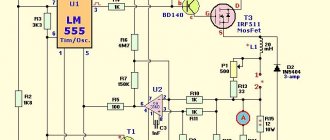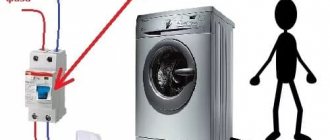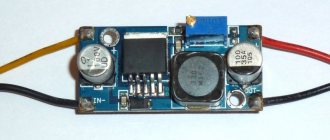An old friend of mine, a seemingly smart guy, came to visit me and somehow casually mentioned that he had bought a cool voltage stabilizer for his TV. In response to my reasonable question - why did he do this, he was surprised and immediately began to list the “indisputable” advantages of this acquisition. However, after just 15 minutes of argument, his confidence faded somewhat.
In general, it is surprising how much we are influenced by marketing ploys. Even seemingly intelligent people with developed critical thinking are easily fooled by various advertising tricks and sweet assurances from salespeople. In the case of stabilizers, I think memories from the distant past came into play - from the good old Soviet Union.
Content:
- 1 What are stabilizers and are they needed?
- 2 Do all TVs need “stability” 2.1 When exactly do you need an uninterruptible power supply?
Power surges are a nuisance familiar to residents of large cities and small towns. They occur due to accidents on the line during periods of bad weather with heavy rain, thunderstorms and wind. And most importantly, such a nuisance is always unexpected, so there is no way to turn off all household appliances in a timely manner. Moreover, each such leap brings closer the “death” of the TV, computer, washing machine. Therefore, it is important to select and install a voltage stabilizer for your TV in advance. Especially if you don’t plan to update the equipment in your home in the next couple of years.
Old tube TVs
The adult generation remembers very well that in the USSR under every TV there was a plastic box called a “voltage stabilizer” that was sure to hum. The box, as a rule, was hot and necessarily heavy.
Of course, TVs could work without these boxes, but any deviation of the voltage in the outlet from 220V led to the image on the screen changing its brightness and saturation, and the picture itself changing in size. So almost everyone had stabilizers.
Such stabilizers worked using the principle of supersaturation of the transformer core and therefore were designed for a narrow range of load powers .
For black-and-white TVs with a power of 100-200 W, some models of stabilizers were produced, and for color TVs - completely different, more powerful ones. It was impossible to include a low-power load in a powerful stabilizer, because in this case, the very principle of its operation was violated and it ceased to perform its function.
Here, for example, is an excerpt from the instruction manual for the Soviet Vega-9 voltage stabilizer:
Allowable output power of the stabilizer: - minimum 100, - maximum 200 W.
Permissible input voltage fluctuations are 154…253 V. Stabilized output voltage is 198…231 V.
Efficiency - 84%. Stabilizer weight 3.4 kg.
As you can see, there was a limitation on the load power from below, i.e. It was impossible to turn on a small black-and-white TV with a power of less than 100 W in such a stabilizer. More precisely, it was possible to turn it on, but in this case one could forget about any voltage stabilization.
If you plug a load of more than 200W into Vega-9 (for example, a color TV of those times), then the stabilizer is guaranteed to overheat and the plastic case begins to melt and stink. I have seen such melted boxes from other people more than once.
By the way, today such old stabilizers for old TVs are called ferroresonant. Today's devices are often assembled using an autotransformer circuit with a large number of taps and triac switching between them.
What are stabilizers and are they needed?
Uninterruptible power supply systems are devices for maintaining stable voltage in conditions of voltage fluctuations. The task is to increase or decrease the intensity of the current supply within the optimal limits of 220 V. And turn off the supply when the intensity level reaches 160 V or less or 255 V or more.
They are included in the basic configuration of any laptop. A stabilizer for the TV has to be purchased separately.
According to the connection method, stabilizers are networked, where the connection is provided for each individual device. Or main ones - connected to all electrical networks leading to the house or entrance.
Advice. If you have a large amount of expensive equipment in your home, you should think in advance about a separate main uninterruptible power supply. It is installed on the cable entering the home. And so it protects all equipment, not just TV.
What to look for when choosing
How to choose a voltage stabilizer, and what parameters should be taken into account. First, you need to look at the power of the system. It should be 20-30% higher than the power of the device to which the connection will be made. If you plan to install a stabilizing device on more than one device, accordingly, all powers are summed up. And it is better to take a system that will exceed the received power by at least 3 times in order to be able to increase the connected equipment.
It should also be taken into account that some devices consume much more power when starting up than in operating mode. Their total power will consist of active and reactive components and is measured in kVA. If the instructions do not indicate anything, then the coefficient by which you need to multiply the active component will be about 0.7 (this will be the reactive part).
Secondly, the stabilization accuracy, that is, what the voltage spread will be at the output of the stabilizer. The instructions for household appliances usually indicate the permissible range, and you need to focus on it.
Single-phase or three-phase. If you have a three-phase network, or have an electric stove or similar high-power equipment, then you can install three-phase stabilizers. Or you can install three single-phase devices. In practice, it is more convenient to work with them and they will cost less than one 3-phase one.
A 220 volt stabilizer cannot be directly connected to a 380 volt network.
Stabilized voltage range. That is, the range of received voltage, beyond which the devices will be turned off.
In addition, these devices can be wall-mounted, floor-mounted, and differ in size and appearance. Here everyone chooses according to their preferences and financial capabilities.
Returning to the question about TVs, let’s summarize: is a voltage stabilizer needed for a TV and which stabilizer to choose for a voltage of 220 V.
Each type of stabilizer can be used in everyday life. Correlating cost and characteristics, the most suitable voltage stabilizer for a TV can be called relay and electromechanical.
To choose a good model for a smart or any other TV, you need to follow the criteria that are already described above and are important when choosing a stabilizer for any equipment. It doesn’t matter what TV model or type you have. Stabilizing devices are universal.
Here are some recommended models:
- For Led TVs that do not consume too much electricity, the Sven AVR-800 is well suited. Is relay;
- Energy SNVT-1500 – electromechanical type. Works fully automatically. Has smooth adjustment and thermal protection. Good for equipment sensitive to changes;
- DefenderAVR real 1000 is a budget relay option. It also acts as a surge protector. Suitable for long-term network load fluctuations.
To summarize, we can say that stabilizing devices are needed if there are constant surges in the power grid. In case of rare and minor changes in modern technology there are switching power supplies that can protect it from damage.
If you nevertheless decide to secure some equipment, for example, a TV, it does not matter its model or panel type, all stabilization devices are universal devices. What is important is the power of the equipment and the limits of stress that it can withstand.
The most suitable for individual units of household appliances are relay and electromechanical stabilizers.
An old friend of mine, a seemingly smart guy, came to visit me and somehow casually mentioned that he had bought a cool voltage stabilizer for his TV. In response to my reasonable question - why did he do this, he was surprised and immediately began to list the “indisputable” advantages of this acquisition. However, after just 15 minutes of argument, his confidence faded somewhat.
In general, it is surprising how much we are influenced by marketing ploys. Even seemingly intelligent people with developed critical thinking are easily fooled by various advertising tricks and sweet assurances from salespeople. In the case of stabilizers, I think memories from the distant past came into play - from the good old Soviet Union.
Do all TVs need “stability”?
The question of purchasing a 220V voltage stabilizer for a TV has been around since the days of large tube models. With each current surge, the image on the display deteriorated, became distorted, and the color changed. Often after a thunderstorm it was necessary to repair or send the TV for repairs.
Modern technology based on matrices such as LED, LCD and plasma is equipped with a switching power supply. It supports current drops in a fairly wide range: from 170 to 250 V. As soon as the values go down or up, the TV automatically turns off. But, if for some reason this does not happen, there is a high probability of breakdown and subsequent repair of the TV.
Some manufacturers, for example, Samsung and LG, produce separate equipment for their TV models. This type of TV protection against power surges is reliable, but costs several times more than analogues from other companies.
It turns out that despite the built-in protection against current surges in TVs, they need a separate stabilizer, especially if the light bulbs in the house blink very often and the lights turn off.
When exactly do you need an uninterruptible power supply?
Despite the presence of a built-in stabilizer in LCD and LED TVs, there are situations when additional equipment is definitely required:
- Constant power surges in the house due to old wiring, frequent thunderstorms and winds.
- A private house where there are always problems with the intensity of the current supply.
- There are often renovation works or construction of new houses going on nearby - there is a high probability that cables will be damaged during construction.
Before purchasing a device, you can measure the total voltage in the network in the house for one or two days. To do this, you need to purchase or borrow a tester from someone. And check the indicators every 1-2 hours.
Such an analysis will help to understand whether a stationary or mainline device is needed. After all, it is better to protect once than to repair appliances in the house many times.
Important! The main uninterruptible power supply is mounted as close as possible to the switchboard. It is advisable to install it immediately after the meter.
Do not confuse pixel burnout on the matrix with the consequences of power surges. Pixels are control transistors. And they do not fail due to voltage. But a complete failure or disappearance of the picture as a whole is already a sign of voltage drops.
Best Double Conversion Voltage Stabilizers
Such devices are widely known as inverters, which are effective, in particular, because they allow electricity to be stored for more stable operation of devices. Before adding a specific product to the rating, we studied 10 different products.
Calm IS1000
This is the best 220V voltage stabilizer for the home in terms of accuracy, which is 98%. Accordingly, the error in power supply normalization does not exceed 2%, which ensures reliable operation of electrical appliances even of high power. There is a transformer of a convenient shape, flat, which can be easily hung on the wall, however, it is white and gets dirty quickly. By the way, this is one of the few models in the rating that has forced cooling, which increases its service life.
The Stil IS1000 is also interesting because it can work with two sockets, and this makes it universal. But there are some restrictions on the operating temperature - the air should not be cooled below +5°C, otherwise it risks failure. Among other options in the TOP, it is distinguished by its wide range of input phase voltage, 90-310V, thanks to which it can be used in completely different networks.
Advantages
- The risk of short circuit is almost completely eliminated;
- Reliable overvoltage protection;
- There is no interference;
- Withstands overload for 5-10 seconds;
- Service life – up to 20 years;
- It hardly gets warm.
Flaws
- Weight 3 kg.
Types of equipment and its features
All stabilizers for TV and other equipment are divided into the following subtypes:
- Step or relay options. Their operating principle is based on switching the windings of a working transformer. If the input voltage changes, the relay closes, which reduces the amount of sinusoidal voltage in the network. The setting in such models occurs abruptly and is accompanied by a specific sound that appears when the relay contacts close. Such options are perfect for networks where surges occur very frequently and over a wide range of volts. In terms of cost, the equipment is the cheapest.
- Electronic uninterruptible power supplies equalize the voltage using triac or thyristor switches. The equipment is quite expensive. But it works silently and with instant adjustment of input parameters.
- Electromechanical devices or servomotor, servo-drive options. They are adjusted using the movement of carbon contacts along the winding due to the operation of the electric drive. Stabilizers of this class have an average price. Adjustment of indicators is smooth. The design has small dimensions. The disadvantages include: it is quite noisy and has a low reaction speed.
- Ferroresonance options have a long service life and low price. They precisely regulate the input parameters. But they have an impressive size, weight and loud noise during operation.
- Inverter stabilizers convert voltage using two methods. At the input it changes to a constant, at the output it changes to a variable. The devices operate absolutely silently. And they are reliably protected from any external interference and power surges. But at the same time, their cost is the highest of all options.
All of these stabilizers are suitable for installation before a TV or other equipment. With optimal technical parameters, they can be installed as main lines and protect the entire line. Moreover, the cost of the latter is much higher than a simple TV stabilizer.
Specifications
Stabilizers are selected taking into account their technical characteristics. They are as follows:
- The power must exceed the corresponding characteristic of the connected device.
- Stabilization accuracy characterizes the maximum deviation at the output from the rated voltage.
- It should be borne in mind that some devices are noisy and can cause discomfort to viewers during operation.
- The acceptable input voltage range means that the indicators within it will produce the required voltage. When you go beyond the boundaries, the TV will be turned off.
- Design and dimensions must be taken into account in order to choose a device that will match the design of the room.
- High performance will allow you to better respond to power surges.
Choosing the right device will allow you to use it for many years.
What are network filters
Modern TV models are equipped with a surge protector - internal protection against power surges. But over time it breaks down and requires replacement. Therefore, it is recommended to take expensive TVs for diagnostics at least once a year to avoid problems with network surges.
Such network voltage stabilizers for LCD and LED TVs include:
- Varistors - they provide resistance at very high pressure, taking it upon themselves. In this case, they usually burn out. The result is reliable, but disposable protection.
- LC filters remove high frequency interference due to the presence of capacitor coils and inductance. These are reusable and fusible fuses. They have a small button on the body. When the voltage exceeds the norm, the button is pressed and opens the target. The device operates automatically. But to start the work, you need to return the button to its initial position.
- Gas dischargers. They are equipped with gas-discharge electrodes along with a varistor. They take on the voltage and quickly eliminate the potential difference.
Important! Absolutely all network filters are equipped with grounding. A good manufacturer will definitely indicate in the instructions which of the lines relates to varistor protection. If there is a varistor only between phase and ground, additional grounding will have to be done. But in the “phase-zero” option, nothing auxiliary is required.
The surge protector itself is a complex device that includes electronic components to suppress impulse noise. They prevent equipment from short-circuiting during voltage surges.
A TV stabilizer is a more complex device that protects against both low and high frequencies and impulse noise. And surge protectors only protect against high levels. Therefore, uninterruptible power supply systems work much better and longer.
Five of the best electronic stabilizers with power up to 10 kW
Above we presented ratings of the most popular relay stabilizers among consumers with a power of up to 1 and up to 10 kW.
Next, we will talk about popular devices with an electronic voltage regulation algorithm. These are more modern and accurate devices, the switching of turns in which is carried out using electronic components - triacs and thyristors, which makes it possible to reduce the stabilization error and noise of operation.
Energotech Norma 9000
Energotech Norm 9000
Manufacture – Russia Cost – about 27,500 rubles
The obvious advantage of this model is that it remains operational at extremely low input voltages - the device turns off when the mains voltage drops to 60 volts. The stabilization error is no more than 7%. Similar characteristics were achieved through 9-level stabilization.
A 9 kW stabilizer can ensure the safe operation of all electrical appliances used at home. The power reserve is enough for an automatic washing machine, an electric stove, and an oven, not to mention less powerful consumers of electricity, such as a TV, computer and refrigerator.
Installing a stabilizer at the dacha will be the optimal solution to the problem of energy supply in conditions of worn-out electrical networks.
Thanks to the use of modern components and high quality assembly, the manufacturer guarantees uninterrupted operation of the stabilizer for 5 years. The operating process of the device is almost silent - switching turns of the transformer using thyristors does not lead to noise. The stabilizer is equipped with protection systems against overvoltage, overheating, and short circuit. The advantages of the model include an ergonomic housing with the possibility of wall installation.
4.Systems Ultra-M 9000
Systems Ultra-M 9000
Manufacture – Russia Cost – about 38,000 rubles
On the fourth line of the rating of electronic stabilizers is the Systems Ultra-M 9000 thyristor device, operating in the voltage range of 110-290 volts with an error of 5%. The device has a 16-step stabilization system. A special feature of this model is a unique transformer with a triple power reserve. With maximum input voltage parameters from 60 to 300 volts, the device provides output values in the range from 209 to 230 volts, which ensures uninterrupted and reliable operation of connected electrical appliances and equipment.
The presence of a microprocessor control algorithm based on thyristors ensures almost silent operation of the stabilizer.
Another feature of this model is its durability - the manufacturer guarantees uninterrupted operation of the stabilizer for at least ten years under conditions of increased loads.
The Sistems Ultra-M 9000 stabilizer will become a reliable protector of household electrical appliances and equipment in a city apartment, country house, or small office.
3. Energy Classic 7500
Energy Classic 7500
Production – Russia Cost – about 27,000 rubles
The total power of this electronic device, which ranks third in the rating, is 7500 V/A. At the same time, the stabilizer has one of the lowest shutdown thresholds. The use of this device is optimal for houses and apartments where permanent fluctuations in the electrical network are observed.
The stabilizer turns off automatically when the mains voltage drops to 60 volts. At the same time, it has a very high reaction time, which allows it to compensate for differences in a timely manner - the correction time is only 20 ms. The efficiency is 98%, which is one of the best indicators in this segment.
It is worth noting that in relation to its power, the model is quite compact and lightweight - the stabilizer weighs only 20 kg, thanks to which the device can be mounted on the wall. The lifespan of the stabilizer declared by the manufacturer is 60 thousand hours or 20 years.
PS Online store where the Energy brand is sold.
Lider PS 10000 w-50
Lider PS 10000 w-50
Manufacture – Russia Cost – about 47,000 rubles
This stabilizer is one of the most expensive in the segment under consideration. This is due to a number of factors. Thus, the device is adapted to operate in a very wide input voltage range. Thanks to the presence of a boost transformer, the stabilizer can operate in the input voltage range from 128 to 320 volts without any problems. The device is completely autonomous and does not require maintenance for the entire period of operation.
Note that among the numerous reviews from the owners of this stabilizer there are practically no negative ratings. Most users note that after installing the stabilizer they completely forgot about the problems with the electrical network supplying their house or apartment.
1.Ortea Atlas 10-10/20
Ortea Atlas 10-10/20
Manufacture – Italy Cost – about 90,000 rubles
The leading position in this rating is occupied by the Ortea Atlas 10-10/20 stabilizer produced by the famous Italian company Ortea, a leading manufacturer of power electrical equipment in the world.
This high-precision and reliable model with a power of up to 10 kVA provides unique voltage stabilization accuracy. Within the range: 176-242V output accuracy is 3%, which cannot be compared with any of the competitors. Beyond 141-266V, a shutdown occurs. ATLAS stabilizers regulate voltage gently and without surges with a unique accuracy of 0.5 to 3%. The light will burn brightly and without blinking. provides 2 years of full warranty and 3 years of free service. Regular maintenance work on the ATLAS comes with a lifetime warranty. ATLAS stabilizers operate at -25oC thanks to the use of frost-resistant components. This will allow you to install them in an unheated room. All electrical equipment connected to ORTEA stabilizers is insured by INGOSSTRAKH for RUB 3,000,000.
This device will be an ideal solution to the problem of safe power supply to homes, offices, and small production sites. The device is adapted to work with a low voltage threshold of 141 volts, which allows it to be adapted to the most worn-out electrical networks. Thanks to its high efficiency exceeding 98%, the stabilizer does not create additional load on the network, saving power consumption in the process of stabilizing high voltage.
Among the main advantages of the stabilizer, it is worth noting the efficient operation of the transformer on current-collecting graphite rollers, a world-patented control system, a multi-level protection system, natural cooling, and the use of frost-resistant components that ensure uninterrupted operation of the device in unheated rooms at temperatures down to -25°C.
Equipment selection criteria
To understand which voltage stabilizer to choose for your TV, you need to know exactly the network parameters. Understand how strong and frequent changes are in the network. After all, all devices have different power, which must be combined with the parameters of the TV.
The main parameters that are taken into account when choosing a device include:
- TV power. It can be found out through the technical passport. And use it to select an uninterruptible power supply indicator.
- In rural areas, additional protection against short circuits is needed. There is a high risk of strong wind gusts and thunderstorms.
- Operation noise level. Important when installing in the house directly next to the TV. Loud noise can ruin your TV viewing experience.
- Network power level range. If the supply intensity in the region drops to 90V, then protection should be turned on against this indicator.
- The dimensions of the unit also matter. There is no point in buying a bulky device that will take up a lot of free space.
Important! When purchasing a stabilizer not only for a TV, but also for other household appliances, it is necessary to take into account the total power of all devices. And use it to select an uninterruptible power supply.
When all the parameters have been calculated, you can decide which manufacturer of stabilizer for your TV to choose. Domestic entrepreneurs offer high-quality devices at an affordable price. Chinese options are the cheapest, but not the most durable. European ones are the most expensive, but they also have high build quality and protection against network outages.
You can buy an uninterruptible power supply from the same company as the TV itself. But such models are usually much more expensive than their analogues. It is worth purchasing equipment in specialized stores. You need to order online carefully so as not to get a “pig in a poke.”
Rating of the best voltage stabilizers
First of all, we studied customer reviews and expert ratings, both positive and negative. A number of tests were also carried out, which helped to identify the winners.
Here are the characteristics we paid attention to when selecting the best voltage stabilizers:
- Product type – relay, electromechanical, inverter;
- Installation method: floor or wall;
- Efficiency level and percentage of error;
- Type of cooling – natural or forced;
- Operating temperature;
- Focus on the number of phases and sockets;
- Switching time between windings;
- The degree of humidity in the room;
- Power;
- The method of supplying voltage information is digital or conventional;
- Reliability of protection against overheating, interference, and increased loads;
- Weight and dimensions;
- Design and color.
When compiling the rating, we also took into account the service life of the devices and the duration of the warranty, the price-quality ratio of the products, and their availability on the market.
How uninterruptible power supplies are connected
Voltage stabilizers for TVs are connected according to the general principle. No additional knowledge or skills are required for external devices. Most models have 5 connectors: input phase, neutral, ground zero, phase, going to the load point.
You can connect devices only when the power supply to the house is turned off. It is advisable to install an auxiliary RCD before the meter to extend the life of the uninterruptible power supply. A grounding loop is provided in the electrical network itself.
Important! You cannot monitor the stabilizer immediately in front of the counter. The optimal installation location is 0.5 meters from the TV, but not closer.
The connection diagram is simple - the stabilizer is plugged into an outlet. And the TV into the device socket marked “output”. The TV can only be turned on after all elements have been connected.
Old tube TVs
The adult generation remembers very well that in the USSR under every TV there was a plastic box called a “voltage stabilizer” that was sure to hum. The box, as a rule, was hot and necessarily heavy.
Of course, TVs could work without these boxes, but any deviation of the voltage in the outlet from 220V led to the image on the screen changing its brightness and saturation, and the picture itself changing in size. So almost everyone had stabilizers.
Such stabilizers worked using the principle of supersaturation of the transformer core and therefore were designed for a narrow range of load powers .
For black-and-white TVs with a power of 100-200 W, some models of stabilizers were produced, and for color TVs - completely different, more powerful ones. It was impossible to include a low-power load in a powerful stabilizer, because in this case, the very principle of its operation was violated and it ceased to perform its function.
Here, for example, is an excerpt from the instruction manual for the Soviet Vega-9 voltage stabilizer:
Allowable output power of the stabilizer: - minimum 100, - maximum 200 W.
Permissible input voltage fluctuations are 154…253 V. Stabilized output voltage is 198…231 V.
Efficiency - 84%. Stabilizer weight 3.4 kg.
As you can see, there was a limitation on the load power from below, i.e. It was impossible to turn on a small black-and-white TV with a power of less than 100 W in such a stabilizer. More precisely, it was possible to turn it on, but in this case one could forget about any voltage stabilization.
If you plug a load of more than 200W into Vega-9 (for example, a color TV of those times), then the stabilizer is guaranteed to overheat and the plastic case begins to melt and stink. I have seen such melted boxes from other people more than once.
By the way, today such old stabilizers for old TVs are called ferroresonant. Today's devices are often assembled using an autotransformer circuit with a large number of taps and triac switching between them.
General instructions for choosing a stabilizer
A stabilizer is needed for all types of TVs if there are frequent voltage drops in the network, regular power outages occur, or the house has old wiring.
The selection and installation itself is carried out according to the following scheme:
- Decide whether to connect one TV or all devices to the stabilizer.
- The choice is to protect the entire network - install a backbone device, or just TV.
- Power outage in the house.
- Equipment installation.
- Starting the TV.
Electrical store employees can help you choose the right model. But for this they will need network parameters and the total power of the devices that will connect to the uninterruptible power supply.
Found a mistake? Select it and press ctrl+enter
- 80
The best electromechanical voltage stabilizers
Such products are servo-drive devices; they are especially relevant in houses with old wiring and cities where the electrical networks have not been updated for a long time. This is the leader among all types of similar units in terms of price and quality ratio. These normalizers consist of a microprocessor responsible for control, an automatic transformer and an electric motor. With their help, the voltage is regulated more efficiently, which reduces the negative impact on electrical appliances.
Resanta ACH-10000/1-EM
This stabilizer is quite large, which may not be very convenient for constant use. The fact is that the device is intended only for installation on the floor. But if the room is spacious, then this should not be a problem. The product is easy to transport due to the wide handles.
Reviews of the Resanta ACH-10000/1-EM voltage stabilizer write only the best, in particular, noting its practicality. It can indeed be used in different operating modes, one of which here is bypass. When switching to it, the current in the network is not corrected; the amplitude is leveled to the required values. This is very important when used in conditions of high humidity, but if its level exceeds 80%, malfunctions may occur. But this happens extremely rarely, and the percentage of stabilization error here is only 2%.
Advantages
- Display of both input and output voltage by voltmeter;
- Withstands temperatures down to -45 degrees;
- Does not require wall mounting;
- Withstands load changes;
- Responds to changes in less than 10 ms;
- Supports operation at voltages of 140-260 V.
Flaws
- Weight 25.5 kg;
- There is not enough forced cooling.
Rucelf SdwII-12000-L
...Using this stabilizer, we can say that it correctly displays voltage of both types - both input and output, almost does not heat up and has a durable housing...
Expert opinion
This is another decent option, operating at 10,000 watts. Unlike the previous model, it can be placed on the wall and will not take up much space due to its thin body. Among its features, it is worth noting the high efficiency of 98% and the adjustment error of up to 1.5%. It is designed for low-power consumers of equipment, since it is intended for use in single-phase electrical networks, but still withstands decent loads.
Advantages
- Availability of bypass;
- Reliable protection from negative influences;
- Warranty period of 365 days;
- Can work in cold temperatures down to -40°C;
- Digital display;
- Black body color.
Flaws
- High price.
- Considerable weight at 27.5 kg.
conclusions
Thus, we have convincingly proven that for any modern TV - be it an LED TV or just an LCD TV - voltage stabilizers are absolutely unnecessary devices (as well as uninterruptible power supplies and, in most cases, surge protectors).
Now the answer to the question - is a voltage stabilizer needed for a TV, I think, is obvious. Just plug your TV into a power outlet and enjoy watching!
You really wanted such a TV for your home. It has Smart TV technology with widgets for YouTube, MEGOGO, Divan.TV, Facebook, Twitter, and if you're lucky, Skype.
Everything is already configured and working. (If not, please contact us :))! Setting up smart TV throughout Ukraine). Your movie or favorite show is waiting for you.

